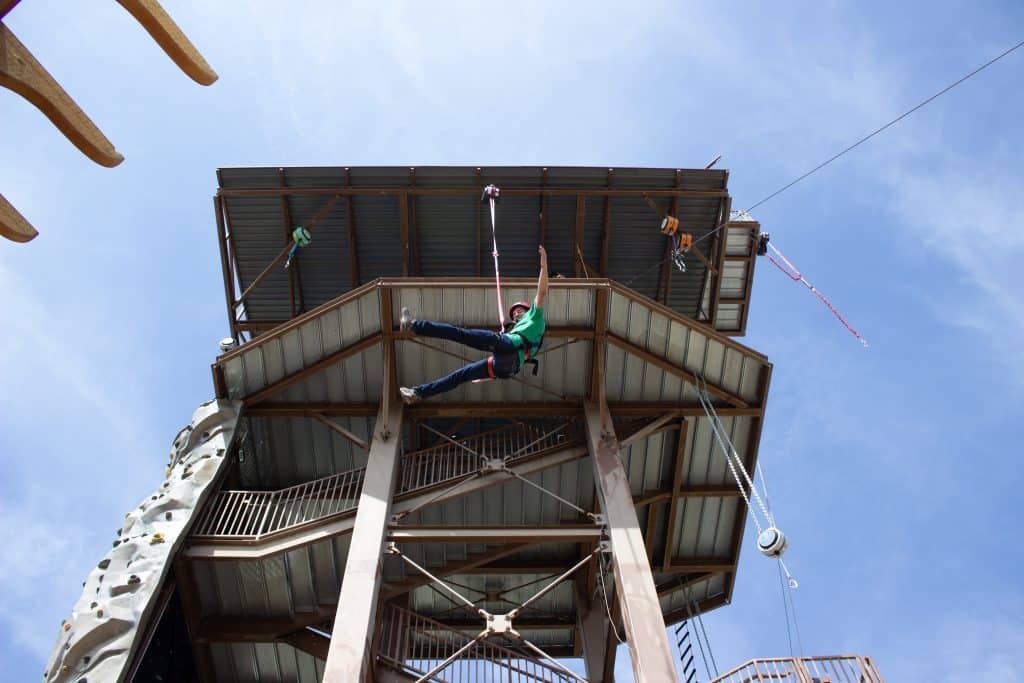Imagine standing on top of a tower with your toes to the edge getting ready to jump off. The tower is not on fire and is not toppling, so why are you jumping? For the thrill of course! We’ve developed a family of free fall devices that offer a wide range of free fall experiences – with jumps ranging from 15 ft (4.5 m) to a sweat-inducing height of 80 ft (24.5 m). The actual free fall distance on these jumps range from 5 ft on the QUICKflight Low Mount Free Fall Device to a whopping 50 ft on the FlightLine Free Fall Device!
But what do we mean by free fall device? What is free fall? You ask and we deliver, so sit back, adjust your pocket protector, and get ready for a free falling physics lesson!
Define Free Fall
To start, we’re going to look at Newtonian physics. This is an area of study on the relationship between force and momentum that is almost completely based on the work of Sir Issac Newton, the apple loving physicist and mathematician.
In Newtonian physics, free fall is defined as the motion of an object where gravity is the only force acting upon it. By this definition then, a skydiver is never in true free fall, even before they deploy their parachute. A skydiver may be pulled towards earth by gravity, but they are also affected by air resistance, a force opposing their downward movement. For this reason it doesn’t match the strict definition of a free fall.
Well, what is free falling, you ask? By the Newtonian definition, the moon itself is in free fall! Because the gravity of earth is the only force acting upon the moon. Though not true free fall devices by this strict definition, we thought it would be impracticable to mount our devices in space or build giant vacuums for each installation. Head Rush’s devices are the most authentic free fall you’ll find in an adventure park on the planet Earth.
For those of you so inclined, feel free to dig further into the details of free fall physics and mathematics.
Free Fall Speed
Without the effects of air resistance, the speed of an object free falling toward Earth would increase by about 32 ft (9.8 m) per second every second. Luckily for skydivers everywhere, they do experience resistance from the air as they fall, and because of that resistance, skydivers and any other object falling within Earth’s atmosphere will reach a terminal velocity.
Terminal velocity is the fastest speed that an object will reach as it falls through the air. As a skydiver jumps, gravity pulls them towards the earth, accelerating their fall. At the same time, air resistance is pushing back on them and increases at higher speeds. A skydiver’s speed will continue to increase until the pull of gravity equals the air resistance pushing against them (or until they deploy their parachute). At this point, they will have reached terminal velocity and will fall at a constant speed, no longer accelerating. The mathematical equation to determine terminal velocity takes into account an object’s mass, gravity’s pull, the resistance provided by air or fluid, and the area of an object.
Enough math, though. Here are some fun free fall facts! When falling in the standard belly-to-Earth position, an average estimate of terminal velocity for skydivers is 120 mph (200 km/h), and a falling person will reach terminal velocity after about 12 seconds, falling some 450 m (1,500 ft) in that time. Peregrine falcons, known for their high-speed dives when attacking their prey, can reach speeds of over 200 mph (322 km/h).
Free Fall Devices
You have a handful of options if you want to experience free fall; you can go skydiving, bungee jumping, or jump with our QUICKflight or FlightLine devices. The beauty of the Head Rush free fall devices is that they require no training to use and can be setup in almost any indoor or outdoor location. No airplanes, bridges, or parachutes required!
These free fall devices still offer great thrills, too! There are a variety of device options for kid jumps, people nervous to take that first leap, or those willing to push their limits to the max. Even someone who had completed over 30 skydives experienced sweaty palms and a racing heart rate when they stepped up to jump with our FlightLine! Read the blog post on Kyle Berkompas’ experience with the FlightLine.
That concludes our physics lesson of the day, no homework required. We hope you learned a little bit more about what free falling is and how our free fall devices offer thrills for everyone!
If you didn’t get your physics fill yet, check out our other physics lesson about Len’z Law and the magic of magnets.



